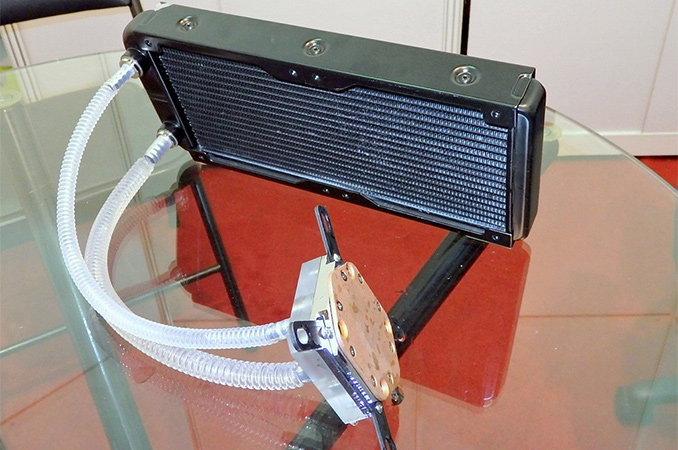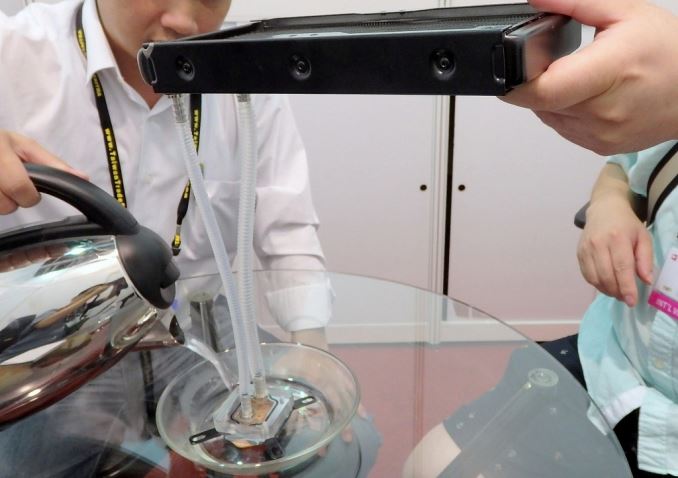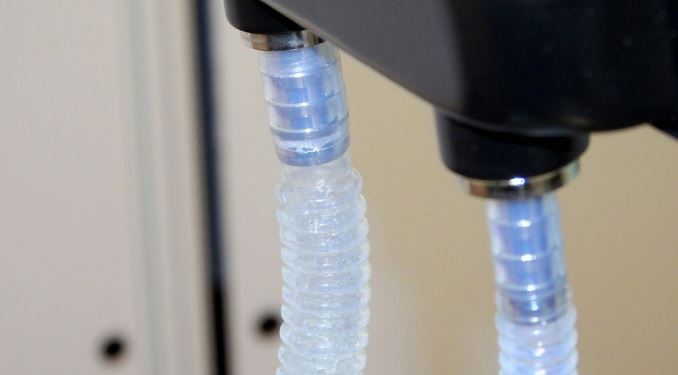Raijintek Shows Off Pumpless Liquid Cooling System
by Anton Shilov on June 3, 2016 10:00 AM EST
In the recent year’s all-in-one liquid cooling solutions gained significant popularity thanks to efficiency and quieter operation. However, even with those improvements, a closed loop cooler still needs a pump to enable circulation of liquid as well as at least one fan to maximize cooling efficiency. Seen as the next step, pumpless liquid cooling systems have been discussed by various developers for a while, and Raijintek demonstrated one at Computex 2016.
The prototype of Raijintek’s pumpless liquid cooling system is comprised of a completely passive CPU/GPU water block with a copper base (featuring a system of very thin channels to maximize heat dissipating surface area) with two nozzles of different diameter, two tubes as well as a radiator (images are by Hermitage Akihabara). The LCS is filled with a customized coolant, which has evaporation point of around 40°C to 50°C. Once the CPU or the GPU gets hot enough, the coolant turns into vapor and streams to the radiator through one of the tubes where it condenses back to liquid, whereas the cool coolant streams back to the water block.
Raijintek's prototype of a pumpless LCS. Image by Hermitage Akihabara.
Natural processes enable the circulation and the liquid cooling system is nearly noiseless (keep in mind that physical processes like water circulation create noises). In the best-case scenario, the higher is the temperature of the chip cooled down by such a LCS, the faster is the circulation. The theoretical limit of TDP that Raijintek’s prototype can handle is unclear, but different reports point to over 200 W, which is in line with traditional high-end and AIO liquid coolers. At Computex, the manufacturer demonstrated the prototype without any fans, but the radiator can be equipped with two of them to maximize cooling performance. While fans are not compulsory, there is a requirement, though: the radiator always has to be installed above the water block, which is something harder to do in small form-factor PCs.
Raijintek's prototype of a pumpless LCS. Image by Hermitage Akihabara.
The advantages of pumpless LCS are obvious: it does not have moving parts and therefore is more reliable than traditional systems; it does not generate as much noise and does not use power, provided that the coolant is cheap enough, the cost of a pumpless LCS should be lower than the cost of a traditional closed-loop liquid cooling system. On the other hand, it is completely unclear how the liquid with a very low evaporation point handles high TDPs when placed in a hot external environment. Besides, temperature of such liquid should remain below 40°C at all times (so, you are not going to use such device in Qatar, where temperatures above 40°C are common). Finally, the LCS must be perfectly sealed to maintain vacuum inside because any slight imbalance of pressure inside will harm its operation, a requirement that potentially increases the cost of the device.
Raijintek's prototype of a pumpless LCS. Image by Hermitage Akihabara.
Raijintek has invested a lot in development of its pumpless LCS over the years. In fact, the first prototype was ready back last year, but the company decided not to demonstrate it, but patent the technology in major markets first. Given the price of the new coolant as well as a new manufacturing process required to build pumpless LCS with vacuum inside, the price of the final product will not be low and may be actually higher compared to traditional AIO liquid coolers.
It is interesting to note that Raijintek is not the first to showcase a pumpless closed-loop liquid cooling system. Back in 2014, Silverstone demonstrated its prototype at Computex, but so far the company has not released it commercially.
Sources: BitTech, Hermitage Akihabara, TechPowerUp, 3DNews.













65 Comments
View All Comments
QB - Friday, June 3, 2016 - link
If I recall my thermal dynamics correctly, it's actually the different diameter tubes that creates the direction of flow.CaedenV - Friday, June 3, 2016 - link
Bingo. Vapor and liquids have different preferences, so vapor will prefer to go up one tube more than the other, while the cool liquid will prefer to go down the other easier. Once things get moving you will get a nice unidirectional flow. You may get a little bit of back flow while things are just starting to warm up, but it would not matter for very long.chuttney1 - Monday, June 6, 2016 - link
This cooler is using the principle of thermosiphoning. The less dense fluid will flow only one way if engineer correctly for cooling.londedoganet - Saturday, June 4, 2016 - link
Cool. Thanks for the insight.HomeworldFound - Friday, June 3, 2016 - link
You mean something like the CoolIT Freezer?http://www.guru3d.com/miraserver/images/2007/cooli...
CaedenV - Friday, June 3, 2016 - link
I am extremely interested in this. Previously I have stayed away from water cooling because it typically adds noise rather than removing it. You still need a fan or two on the radiator, and then you are introducing pump noise; which while quiet, tends to be harsher on the ears than fan noise.But if this can passively cool up to 200W, then I could potentially pick up 2 and go totally fanless... provided I do some modding to promote a good thermal draft through my case, which should not be terribly difficult to do. I suppose there is still a fan in the PSU, but it does not kick on unless I am under a large load, and after moving from the GTX570 to a GTX960 that rarely ever happens anymore.
CaedenV - Friday, June 3, 2016 - link
... a GTX1070 supposedly only drinks 150W at stock... hmmmShieTar - Friday, June 3, 2016 - link
Getting a fanless draft through your case to keep the SSD and Mainboard-Chipset cool may be more difficult than you expect. At least with the higher performance versions of these chips.rahvin - Friday, June 3, 2016 - link
Adds noise? What are you smoking? My computer is water cooled and it's near silent. Yes there is a very very small pump noise, but it's not high pitched like fans and the decibel level is so low you wouldn't be able to tell it's even on except for the lights on the case.Your typical fan cooled computer sounds like a vacuum cleaner when it's on. There is no comparison noise wise between water and air cooling. Anyone that suggests air cooling is better than water cooling for noise has never actually heard a water cooled computer.
Murloc - Friday, June 3, 2016 - link
you often read on the internet about pump noise complaints, and people have different sensitivities and pumps make different noises, so I don't think it's that clear-cut considering the cost compared to air cooling.This may bridge the gap, being the GPU the noisiest to cool component.